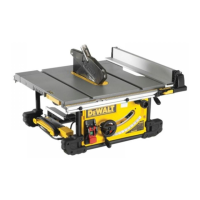17
ENGLISH
Parallel Adjustment (Fig. A, J, K, P, Q)
WARNING: A misaligned fence, not parallel to the blade,
increases the risk of kickback!
For optimum performance, the blade must be parallel to the
rip fence. This adjustment has been made at the factory. To
re-adjust:
Position 1 Fence Alignment
1. Install the fence in position 1 and unlock the rail lock
lever
5
. Locate both locator pins
29
that support the fence
on the front and rearrails.
2. Loosen the rear locator pin screw and adjust the alignment
of the fence in the groove until the fence face is parallel to
the blade. Make sure you measure from the fence face to
the front and back of the blade to ensurealignment.
3. Tighten the locator screw and repeat on the left side of
theblade.
4. Check rip scale pointer adjustment(Fig.K).
Position 2 Fence Alignment
1. To align position 2 fence locator pins
29
, ensure
position 1 pins have been aligned, refer to Position 1
FenceAlignment.
2. Loosen the position 2 pins, then using the blade wrench
holes as a guide for positioning, align the pins(Fig.Q).
3. Tighten the locator pins(front and rear).
Adjusting the Rip Scale (Fig. A, K)
1. Unlock the rail lock lever
5
.
2. Set the blade at 0° bevel and move the fence in until it
touches theblade.
3. Lock the rail locklever.
4. Loosen the rip scale indicator screws
31
and set the rip
scale indicator to read zero(0). Retighten the rip scale
indicator screws. The yellow rip scale(top) reads correctly
only when the fence is mounted on the right side of
the blade and is in position 1(for zero to 62 cm ripping)
not the 82.5 cm rip position. The white scale(bottom)
reads correctly only when the fence is mounted on the
right side of the blade and in position 2(for 20.3 cm to
82.5cmripping).
The rip scale reads correctly only when the fence is mounted to
the right of theblade.
Rail Lock Adjustment (Fig. A, L)
The rail lock has been factory-set. If you need to re-adjust,
proceed as follows:
1. Lock the rail lock lever
5
.
2. On the underside of the saw, loosen the jam nut
33
.
3. Tighten the hex rod
34
until the spring on the locking
system is compressed creating the desired tension on the
rail lock lever. Retighten the jam nut against the hexrod.
4. Flip the saw over and check that the fence does not move
when the lock lever is engaged. If the fence is still loose,
tighten the springfurther.
Bevel Stop and Pointer Adjustment (Fig. M)
1. Raise the blade fully by rotating the blade height
adjustment wheel
6
clockwise until itstops.
2. Unlock the bevel lock lever
7
by pushing it up and to the
right. Loosen the bevel stop screw
36
.
3. Place a square flat against the table top and against the
blade between teeth. Ensure the bevel lock lever is in its
unlocked, or upposition.
4. Using the bevel lock lever, adjust the bevel angle until the
blade is flat against thesquare.
5. Tighten the bevel lock lever by pushing itdown.
6. Turn the bevel stop cam
35
until it firmly contacts the
bearing block. Tighten the bevel stop screw
36
.
7. Check the bevel angle scale. If the pointer does not read 0°,
loosen pointer screw
37
and move the pointer so it reads
correctly. Retighten the pointerscrew.
8. Repeat at 45°, but do not adjustpointer.
Mitre Gauge Adjustment (Fig. A)
To adjust mitre gauge
10
loosen knob, set to desired angle and
tightenknob.
Body and Hand Position
Proper positioning of your body and hands when operating the
table saw will make cutting easier, more accurate andsafer.
WARNING:
• Never place your hands near the cuttingarea.
• Place your hands no closer than 150mm from
theblade.
• Do not cross yourhands.
• Keep both feet firmly on the floor and maintain
properbalance.
Prior to Operation
WARNING:
• Install the appropriate saw blade. Do not use
excessively worn blades.The maximum rotation speed
of the tool must not exceed that of the sawblade.
• Do not attempt to cut excessively smallpieces.
• Allow the blade to cut freely. Do notforce.
• Allow the motor to reach full speed beforecutting.
OPERATION
Instructions for Use
WARNING: Always observe the safety instructions and
applicableregulations.
WARNING: To reduce the risk of serious personal
injury, turn tool off and disconnect tool from power
source before making any adjustments or removing/
installing attachments or accessories. An accidental
start-up can causeinjury.
The attention of UK users is drawn to the “woodworking
machines regulations 1974” and any subsequentamendments.

